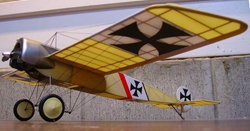Fokker
EIII 24.75" EZ Build N167
Skill Level: Intermediate
More
than 130 parts
SPECIFICATIONS
Scale:
1/16
Prop:
7x4
Channels:
R/E/T
Wheels: Balsa Ply w Neo Tires
Airfoil Type: Scale number of flat bottomed ribs
Wing
Area: 100 sq in
Cowl:
built up balsa
Designer:
M.K.
Bengtson
Weight:
3.5-4oz
Spinner:
N/A
Power
System: GPS IPS
Does not include Instruction Manual
FEATURES
- One piece construction
- Box front fuselage, built up rear
- Built up cowl
- Scale undercarriage
- No dihedral needed but some washout is recommended
HISTORICAL SIGNIFICANCE
The Fokker E series monoplanes were the first truly effective fighter aircraft. The reason, is that for the first time, a machine gun was placed to fire directly through the propeller. The whole aircraft could be aimed at the target. Finally, accurate targeting was possible. The result was spectacular for the Germans and a disaster for the Allies. Allied observation aircraft became the primary target. The period was referred to as the Fokker Scourge. Before that time, observation aircraft could do their work unfettered with the concern of being shot down. Observation aircraft were designed for optimum stability as a camera platform. Agility and speed were contrary to their purpose. The idea that these aircraft were obsolete or not technically advanced is not the case. Taking aerial photographs with existing camera technology was difficult and required a slow aircraft with low engine vibration characteristics. Further, it required a two man crew. The pilot needed to reach the correct location and verify the target. The camera man needed to concentrate on taking the photographs. Remember in those days, there were no accurate aerial maps and from above, orientation is not easy. Landmarks do not look the same from 5000 feet. Pilots did get lost. A major reason for the Fokker Scourge could be that the "Fokker Fodder" were not designed to consider defensive measures. With hundreds perhaps thousands of Allied vulnerable observation aircraft in the air, it was carnage. The Allies had too much invested and needed the information so badly that these unfortunate crews had to endure the Fokker menace. Later, observation aircraft were fitted with machine guns and could fly higher and faster to counter the Fokker.
